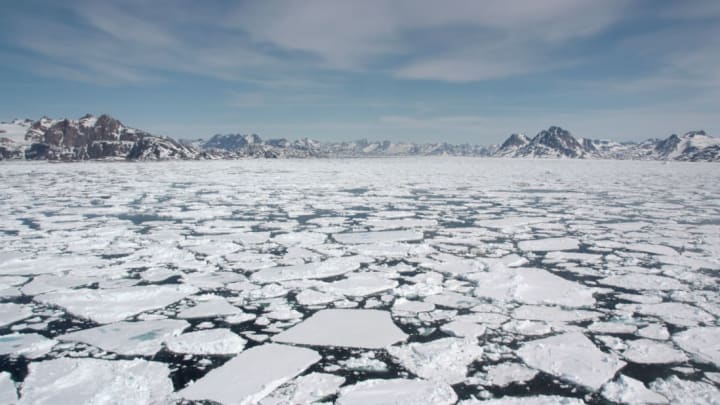The sea off Greenland's northern coast has long been referred to as "the last ice area.” The ice there is so old and thick that scientists believed the shelf would be the last to remain intact in the area in the face of climate change. Now, a new development is challenging that assumption: As The Guardian reports, the strongest sea ice in the Arctic has started to break apart for the first time in recorded history.
The ice above Greenland owed its fortitude up to this point to the Transpolar Drift Stream. Ice from Siberia carried by the current collects on Greenland's coast, condensing to create a sturdy ice pack that's more than 13 feet thick, with ridges exceeding 65 feet in some places. The ice has remained whole at least since scientists started keeping satellite records of it in the 1970s, but an unusually warm and windy year has compromised its integrity.
The breaking sea ice has been documented twice this year—once in February and once in August, both times when temperatures spiked above the averages for the region. The heatwaves weakened the ice and dislodged it from the coast, and warm winds pushed it further from land, creating a patch of open water larger than has ever before been observed in the Arctic. Temperatures will eventually drop back down and the gap will close up, but that won't be enough to reverse the damage. The ice has already been displaced to a spot where it will melt more easily the next time warm weather arrives up north.
Climate scientists are rethinking how global warming might reshape the Arctic. Now that "the last ice area" has started to break up, experts are now saying the true last holdout of the region may be further west. Norwegian Meteorological Institute scientist Thomas Lavergne described the phenomenon as "scary" on Twitter.
Less permanent sea ice means polar bears will have fewer areas for hunting marine mammals, their main food source. New gaps in the ice can also trigger a feedback loop: While white ice reflects the Sun's heat, the dark ocean surface absorbs it, raising temperatures and causing ice to melt faster, feeding a perilous cycle. Arctic ice cover at both poles has been shrinking at a rapid rate in recent decades, with the Larsen C breaking off from Antarctica last summer and forming an iceberg the size of Delaware. Scientists predict that there will be no summer ice present in the Arctic Ocean at all starting some time in the next 10 to 30 years.
[h/t The Guardian]
